Pennsylvania is home to many tree frogs, and many people don’t even know that. From now on you can think of this place as a rich habitat of 6 colorful & tough tree frogs. This tiny critter plays a crucial role in the ecosystem of Pennsylvania.
In Pennsylvania you will find 6 species of Tree Frogs – Northern cricket frog, Spring peeper, Gray tree frog, Mountain chorus frog, and Upland chorus frog.
In this article, you will see the range, habitat, breeding season, calling sound, lifespan, size, and skin color of this squishy frog.
So without cutting any more time let’s see them below!
1. Northern cricket frog
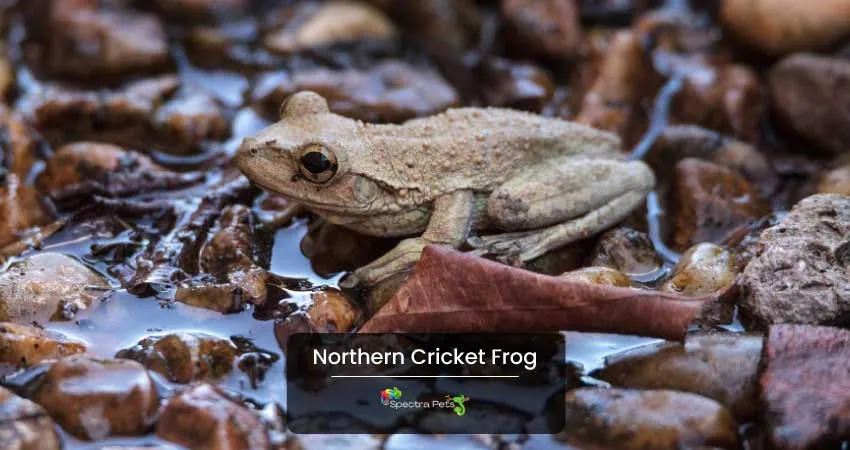
They are famous for their calling sound which is almost similar to the cricket sound. Due to their nature, they like to stay close to rich vegetation zones.
Spreading over a massive area of Pennsylvania, Oklahoma, Alabama, Texas, South Dacota, and Allapachian; they have a stable population in these states.
Though small in size, their defense mechanism is awesome. Using their strong leg muscle these tiny critters can jump up to 3 feet which help them to dodge their hunters like a pro. Adding to that, they are also good swimmers.
The skin color of this tree frog is either green, black, brown, gray, or yellow. Their back skin has irregular dark spots. Their small size of 1.5’’ doesn’t mean their food list is short. These aggressive hunters eat a large number of mosquitos, flies, termites, ants, and beetles.
Due to their terrestrial nature, Northern cricket frogs spend most of their time on the forest floor. The natural habitat of this species includes the edge of marshes, shallow water bodies, slow streams, sunny marshes, farm ponds, etc.
Regarding lifespan, they have an average lifespan of 1 year and hit sexual maturity before getting 1 year old. The breeding season of these amphibians starts in June and continues until August. Each female can lay up to around 400 eggs after mating with one male.
2. Spring peeper
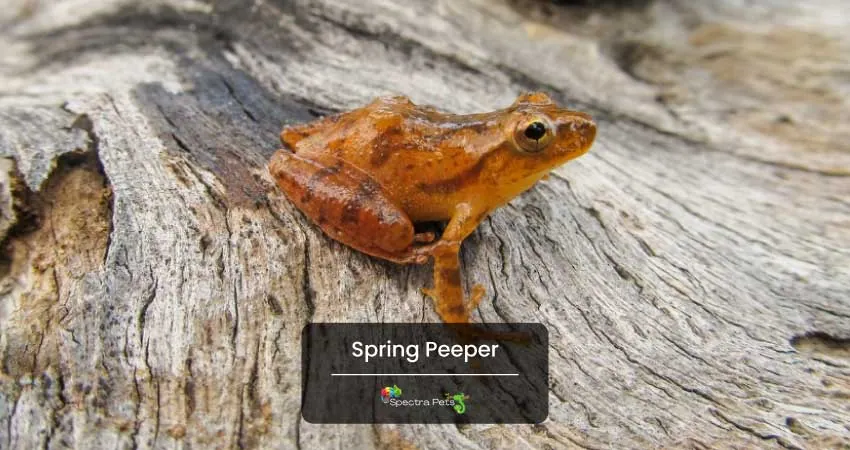
This nocturnal animal is a pretty-looking species that can be seen in versatile color shades like gray, brown, reddish, green, tan, or oink. Alike other tree frog members they live on eating up a bunch of beetles, ants, moths, spiders, and flies.
Plus, their eating time can be early morning, late afternoon, or early evening. Predator like salamanders, owls, large spiders, etc kills them for a living. In Pennsylvania, they are the least concerned frogs although in states like Kansas they are threatened.
Compared to other tree frogs, they get a fairly long lifespan with an average of 3-4 years old in wild. These tiny frogs’ daily travel range is around 20-130 feet. Adding to that, this slender frog can grow up to 1.5″.
On top of that, the gluey toe pad, tiny body size & light body weight makes them mind-boggling climber. Due to their outstanding climbing ability, they become a hard target for predators.
Moreover, this tree frog spends a long time resting high on tree branches. They breed in April-June and the male emits a loud beeping trill to get the attention of the female. Around 1 year of age, both males & females hit sexual maturity.
In addition to that, the distinction between male & female is clear, where the daddy frog is darker & small. While the mommy frog has a light skin tone & big size.
Unlike many other amphibians, the winter does not stop them from going on. Their excellent hibernation ability provides immense support to pass the winter swiftly.
3. Gray tree frog
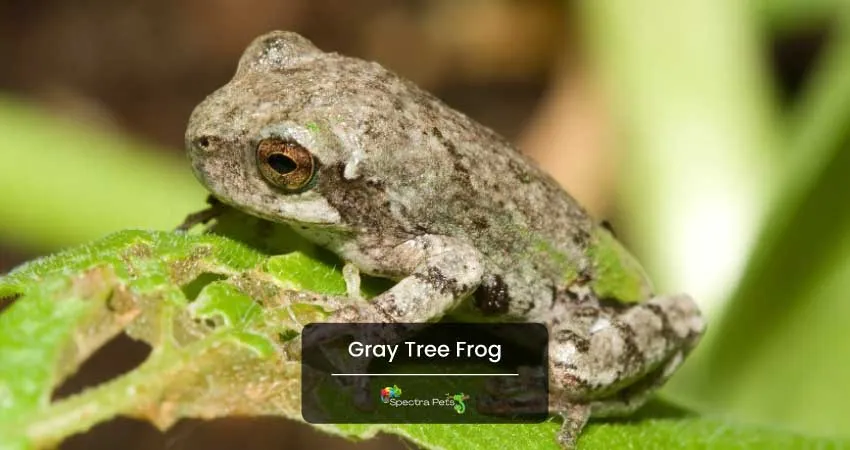
Listed as the least concern, the Gray tree frog has a substantial population in many states of the USA. This wonderful creature is built to survive the hot summer & spine-chilling winter.
Along with Pennsylvania, they are heavily found in Wisconsin, Kansa, Ohio, Oklahoma, Texas, etc. During daylight, they appear dark in color while at night they become lighter in color.
This tree frog is also available in a big part of the eastern USA like Oklahoma, Ohio, Texas, Kansas, Wisconsin, Florida, etc. They are blessed with an amazing capability to survive the mid-level summer, the freezing cold & the snowy weather.
Regarding natural habitat, they prefer areas like wooded zone close to swamps, agricultural land, and mountain streams. One of the amazing attributes of this frog is it changes its skin color to a brown shade when takes rest or shelter under tree roots, tree holes, and leaf litter.
These squishy amphibians hit their sexual maturity when they are 2 years old. When it comes to longevity, these species have a 7-9 years average lifespan in the wild.
From the beginning of the Spring to the end of Summer, they engage in mating activity. And in this whole time, the male tries to attract as many female frogs for breeding purposes. The Male’s high pitch, fast & flutey trill immediately attracts the female.
If you look at other Hylidae members, the Gray tree frog would be one of the largest with a 2.25″ size. This fast & intelligent eater lives on feeding small invertebrates, spiders, slugs, snails and mites, etc.
4. Mountain chorus frog
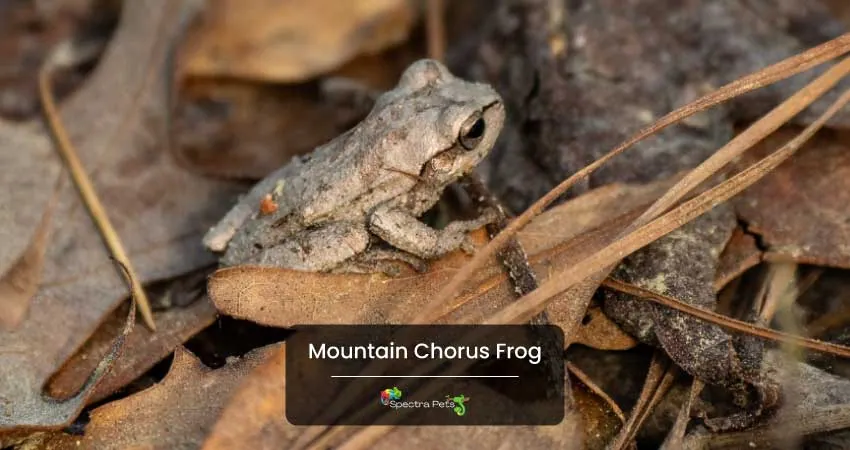
The mountain chorus frog is a frog native to the mountains of Pennsylvania, Ohio, Kentucky, West Virginia, etc. It is common in moist, near-coastal areas at elevations up to 3,500 feet.
Plus, the natural habitat of this species includes roadside ditches, mountain bogs, woodland springs, temperate forests, swamps, etc.
After the breeding season, winter appears and before that, they go to hillsides to enter into hibernation mood to safely pass the tough cold atmosphare.
Moreover, the average lifespan of a mountain chorus frog is 4-5 years and they live more in captivity. The breeding season of this mountain species stays from April to the end of May.
Also. the mountain chorus frog has special adaptations for living in its particular habitat. Its skin color allows it to blend into its surroundings which helps it avoid predators.
Mountain chorus frogs’ skin tends to be brown, olive, gray, and greenish-brown. They have dark blotches on their back. This tiny smooth skin critter can grow up to 1.25’’ long. Their defense technique is to stay in dense vegetation areas to stay out of the sight of a potential predator.
Their diet is packed with insects such as ants, beetles, flies, moths, grasshoppers, and crickets. They also eat small slugs or snails if they find them in their environment.
5. Western chorus frog
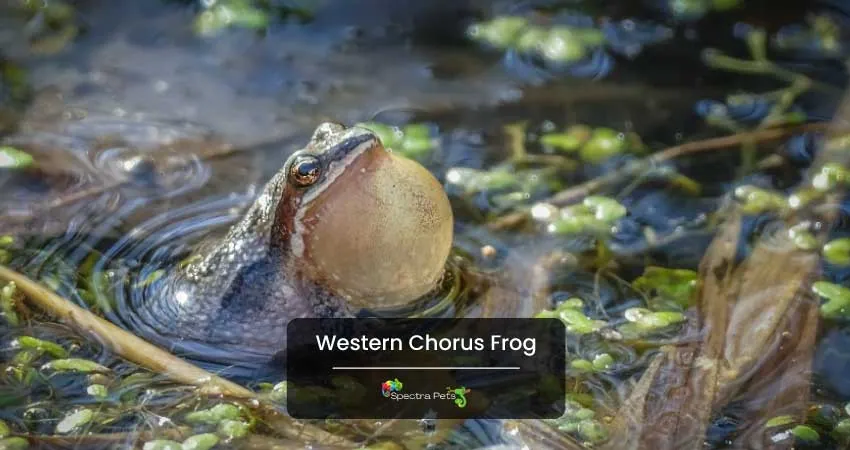
This species got its name changed recently, it was called the Western chorus Frog & now known as the Midland chorus frog.
They always want to stay in a temperate zone that’s covered with a high amount of vegetation. It also boosts their physical growth & provides them comfort. These species inhabit a wide range of habitats, including roadside ditches, marshes, agricultural land, grassy pools, bogs, sub-urban areas, meadows, and riparian areas.
Plus, the brown, gray, greenish-gray, olive, and reddish colors give them the natural advantage to become less noticeable on their natural chilling ground. If they get access to abundant food resources, then they will reach up to 1.5″.
Their food list is filled up with springtails, ants, snails, caterpillars, and beetles. These nocturnal guys start food searching at night. Just like they consume a lot of insects they become food for many predators like raccoons, mink, salamanders, snakes, crayfish, etc.
Moreover, passing the icy winter without many headaches is not tough for them as they go for hibernation under the tree log or beneath the ground.
The male calls out for the female by emitting a loud repeated sound. From March-June, this critter enjoys the company of the opposite gender. At the post-mating time, the female lays close to 1400 eggs in a single season. Luckily a good percentage of these eggs turns into adult Western chorus frog.
Generally, this frog survives around 1 year while few can make a 3+ year journey in the wild. Adding to that, at the age of 1 year, the male becomes sexually mature & within 1-2 years the female gets ready for the reproduction process.
6. Upland chorus frog
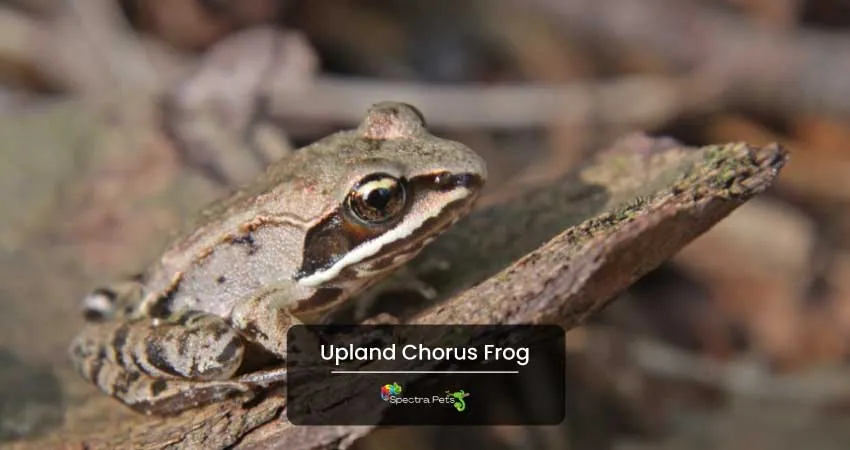
These little amphibians are the dwellers of Pennsylvania, Alabama, Florida, and the southeastern portion of the USA. Size can be lower around 0.7″ and highest up to 1.5″.
It’s easy to detect the male & female due to their physical attributes. The male has a large size vocal sac which is missing in the female. Regarding skin marks, a dark long stripe goes through their nostril to the eye to the side of their body.
This tree frog loves to live in moisture-loaded areas like marshes, water bodies, ponds, meadows, etc. Along with that, these species also like to wander in woodland zones.
Right from the beginning of November to March, the upland chorus frog continues their breeding journey. The male calls out by making a high-pitched sound that resembles a fingernail running over a comb.
It’s a rare event to see this amphibian in broad daylight. Nighttime is their hunting & feeding time. They consume a good diet that’s packed with multiple insects, spiders, beetles, snails, etc.
Furthermore, the gray, dark brown, greenish-brown, tan, and reddish-brown skin color of this critter works as an amazing camouflage. They literally get lost in the vision of the predator. Although they are a Hylidae member, they spend maximum time on moist leafy ground.
Understanding Tree Frog Behavior
Tree frogs, with their varied vocalizations and behaviors, represent a fascinating dimension of Pennsylvania’s wildlife. Their calls, primarily used for communication, resonate through the region’s woodlands, offering not just nature’s symphony but also an insight into their intriguing lives.
Communication Through Calls
Each species of tree frog has its unique call, a result of evolution fine-tuning their voices for specific purposes. For instance, the Northern Cricket Frog produces a series of sharp, metallic clicks reminiscent of two stones being struck together. This distinctive sound is a beacon for attracting mates and establishing territorial dominance.
In contrast, the Spring Peeper’s call stands out as a repetitive high-pitched “peep.” Residents of Pennsylvania often associate this call with the onset of the mating season, a herald of warmer days to come.
The Gray Tree Frog’s voice offers a short, musical trill. While it’s certainly pleasing to the ear, its primary purpose is procreation, with males using it to woo potential mates during the breeding season.
The Mountain Chorus Frog, Western Chorus Frog, and Upland Chorus Frog also have their unique vocalizations, with each serving the dual purpose of mating and setting territorial boundaries.
Dietary Habits
Tree frogs, despite their diminutive size, are voracious predators in the insect world. The Northern Cricket Frog, for instance, primarily feasts on small beetles, ants, and spiders. Their diet ensures they play a crucial role in keeping insect populations in check, thereby maintaining ecological balance.
Similarly, the Spring Peeper’s diet is rich in beetles, ants, mites, and spiders. This broad spectrum of prey not only ensures their survival but also means they actively participate in the intricate food web of Pennsylvania’s ecosystem.
The Gray Tree Frog, Mountain Chorus Frog, Western Chorus Frog, and Upland Chorus Frog, while having some variations in their diet, predominantly feed on small invertebrates. This consistent insectivorous diet means that these frogs contribute significantly to insect population control in their habitats.
Mating and Reproduction
The cycle of life for tree frogs, like most amphibians, is a marvel of nature. Most species reproduce during the spring and early summer. Females lay hundreds of eggs in water bodies, which soon hatch to release tadpoles. These tadpoles, while reminiscent of fish, will eventually undergo metamorphosis to take on their adult forms. However, their journey is perilous, with many facing threats from aquatic predators like fish, newts, and even other frogs.
Where to Spot Tree Frogs in Pennsylvania: Best Locations and Times of Year
State Forests and Parks: Pennsylvania’s state forests and parks are some of the best places to spot tree frogs. Rothrock State Forest, for instance, is renowned for its vernal pools, making it a prime breeding ground for the Spring Peeper. On warm spring nights, the chorus of Spring Peepers in Rothrock can be so loud that it’s audible from miles away. Meanwhile, Loyalsock State Forest boasts streams and ponds that are home to a myriad of tree frog species. It’s one of the rare places where you can find all six species of tree frogs native to Pennsylvania.
Wetland Reserves: Wetlands like the Tinicum Marsh within the John Heinz National Wildlife Refuge play host to a diverse range of amphibian life. Mountain Chorus Frogs are especially common here. Research from 2018 by the Pennsylvania Department of Conservation has underscored the critical role such wetlands play in supporting amphibian biodiversity.
River Basins: The basins of rivers, such as the Susquehanna, are also vital habitats. The Northern Cricket Frog, for example, thrives along riverbanks. Dr. Hannah Green, a renowned herpetologist, has referred to the Susquehanna Basin as “an unsung hero of amphibian conservation.”
When to Visit: Spring sees a surge in tree frog activity, especially during humid nights. Summer evenings, particularly after showers, echo with their calls. By early fall, as tree frogs prepare for hibernation, dusk becomes a prime time for observation.
How to Respectfully and Safely Observe Tree Frogs in their Natural Habitats
It’s essential to approach the act of observing tree frogs with respect and caution. Distancing oneself is key. Frogs have a unique stress hormone that can surge upon close human contact. Thus, experts advise maintaining a safe distance to keep them at ease.
Moving softly and causing minimal vibrations is also essential. A study from Pennsylvania State University discovered that even slight ground disturbances can deter frogs from calling out, which is vital for their mating rituals.
When night falls, and tree frogs become particularly active, a red flashlight can be invaluable. Frogs perceive the light spectrum differently from us, and red light is the least disruptive to their nocturnal activities.
While in protected areas or state parks, it’s crucial to adhere strictly to guidelines. Pennsylvania takes the conservation of its natural habitats seriously, and any disruptions can lead to consequences. Furthermore, it’s worth noting that while the urge to touch or handle these creatures can be strong, it’s best avoided. Not only can human touch distress the frogs, but certain species, like the Gray Tree Frog, can produce skin-irritating secretions.
If in the company of others, especially children, take a moment to share the importance of respectful observation. Several children’s books touch upon tree frogs and their conservation, offering a gentle introduction to the world of herpetology.
Tree Frogs and Pennsylvania’s Ecosystem
Tree frogs are much more than just melodious voices in Pennsylvania’s forests. They are integral cogs in the ecological machine, ensuring balance and offering insights into the health of their environments.
Role in the Food Chain
Tree frogs might be small, but their influence on the food chain is significant. As predators, they keep insect populations in check. This balance means that crops and plants face fewer pests, ensuring healthier growth and reduced reliance on pesticides.
But their role isn’t just that of a predator. Tree frogs are also prey for a myriad of species, including birds, snakes, and larger amphibians. Their existence ensures that these predators have a reliable food source.
Bioindicators of Environmental Health
Their permeable skin makes tree frogs particularly sensitive to environmental changes. As such, they are often considered bioindicators. A thriving tree frog population is usually a sign of clean water bodies, as these amphibians are exceptionally sensitive to water pollutants. Conversely, declining numbers can raise alarms about potential environmental issues, be it water contamination or airborne pollutants.
Contribution to Biodiversity
Tree frogs, with their varied species and behaviors, add a rich tapestry of life to Pennsylvania’s ecosystems. They contribute to the genetic diversity of the region, ensuring that the ecosystem remains resilient and adaptable to changes.
Dr. Johnathan Wallace, a herpetologist from Pennsylvania State University, once remarked, “The role of tree frogs in Pennsylvania’s ecosystem cannot be overstated. Their presence and health are direct indicators of our environment’s well-being.”
Threats to Pennsylvania’s Tree Frogs
Tree frogs in Pennsylvania, while resilient, are not immune to challenges. Several factors threaten their existence, and understanding these threats is crucial to their preservation.
Habitat Destruction
Arguably the most pressing threat, habitat destruction is often a result of urbanization and land development. As forests are cleared and wetlands drained for infrastructure and agricultural expansion, tree frogs lose crucial breeding and feeding grounds. Every species from the Northern Cricket Frog to the Upland Chorus Frog requires specific habitats for breeding and survival, and when these are disrupted, entire populations can be endangered.
Pollution
Due to their permeable skin, tree frogs are highly sensitive to pollutants. Whether it’s chemicals leaching into their aquatic breeding grounds or airborne contaminants affecting their woodland habitats, pollution has a severe impact on their populations. The Gray Tree Frog and Spring Peeper, for example, which thrive around freshwater sources, can face rapid declines in polluted environments.
Climate Change
Changes in temperature and rainfall patterns due to global climate change pose unpredictable challenges. Warmer temperatures can impact the availability of their insect prey, while unpredictable rainfall can affect their breeding cycles, especially for species like the Mountain Chorus Frog which relies on seasonal ponds for reproduction.
Predation and Competition
Natural predation, while a part of the ecosystem, can become a threat when combined with other human-induced challenges. Moreover, the introduction of invasive species can disrupt the natural balance, leading to increased competition for resources and habitat.
Conservation Efforts for Tree Frogs in Pennsylvania
Recognizing the threats faced by tree frogs, numerous organizations and individuals in Pennsylvania have taken steps to ensure their conservation.
Protected Areas and Reserves
Pennsylvania has several protected areas where tree frog habitats are conserved. These areas are kept free from urban development and offer a sanctuary for these amphibians. Some of these areas have seen populations of Western Chorus Frogs and Upland Chorus Frogs stabilize or even grow.
Research and Monitoring
Research institutions like the Pennsylvania State University are actively studying tree frogs. By understanding their behavior, dietary habits, and breeding patterns, conservationists can devise more effective strategies for their preservation. Continuous monitoring helps in early detection of potential threats or population declines.
Public Awareness Programs
Educating the public is key. Several programs aim to enlighten residents about tree frogs, their importance in the ecosystem, and the threats they face. By fostering a sense of responsibility and appreciation, these initiatives hope to involve the community in conservation efforts.
Final words
Tree frogs have been a key player in the ecosystem of Pennsylvania state. If you didn’t notice these tiny neighbors, from now on, it would be a new experience to see them roaming around their habitat close to marsh & swamps.
It was a pleasure to tell you about the tree frog in Pennsylvania, I hope you got a good idea.
Tree Frogs Found in the Nearby States of Pennsylvania:
